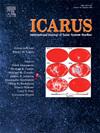大气逃逸解释了冥王星和塞德娜不同的表面组成
IF 2.5
2区 物理与天体物理
Q2 ASTRONOMY & ASTROPHYSICS
引用次数: 0
摘要
柯伊伯带天体被认为是早期太阳系物质的残余物,其中保留了挥发性物质,如CH4和C2H6。来自各种来源的光谱数据显示,虽然冥王星保留了CH4和C2H6,但塞德娜显示缺乏CH4,但C2H6丰富(Emery et al. 2024)。我们假设,虽然CH4在冥王星上很稳定,但它能够从质量较小的塞德娜中迅速逃逸,随着太阳系的年龄而耗尽,而C2H6由于其较大的分子质量而被保留下来。在给定物体质量和逃逸物种的条件下,利用Jeans逃逸模型和流体动力学逃逸模型,分析了冥王星和塞德娜上CH4和C2H6的稳定性和逃逸率。我们探索了塞德娜的大范围质量,从冥王星质量的1 / 2到⅒,以及三种不同丰度的CH4和C2H6,使用了67-P彗星和土卫二的测量值,并假设了笼形水合物的上限。我们发现CH4在冥王星上保持稳定,但由于其质量较低而从塞德娜逃逸,而C2H6在100%和10%的排气率下都保持稳定。这一结果与观测到的光谱一致,并导致塞德娜的质量约束更严格。我们的模型也解释了另一颗柯伊伯带天体“公公”上没有甲烷的现象。本文章由计算机程序翻译,如有差异,请以英文原文为准。
Atmospheric escape explains diverse surface compositions of Pluto vs Sedna
Kuiper Belt Objects are thought to be remnants of early solar system materials, which have retained volatiles such as CH4 and C2H6. Spectroscopic data from various sources reveals that while Pluto retains CH4 and C2H6, Sedna shows a lack of CH4 but an abundance of C2H6 (Emery et al. 2024). We hypothesized that CH4, while stable on Pluto, is able to escape from less massive Sedna sufficiently rapidly to be depleted over the age of the solar system, while C2H6 has been retained due to its larger molecular mass.
Utilizing models for Jeans escape and hydrodynamic escape, as appropriate for a given mass of object and of escaping species, we analyzed the stability and escape rates of CH4 and C2H6 on both Pluto and Sedna. We explored a wide range of masses of Sedna, ranging from ½ to ⅒ the mass of Pluto, and three different abundances of CH4 and C2H6 using measured values from Comet 67-P, and Enceladus, and an upper limit assuming clathrate hydrate.
We find that CH4 remains stable on Pluto, but escapes from Sedna due to its lower mass, whereas C2H6 remains stable when using both 100 % and 10 % outgassing rates. This result is in agreement with the observed spectra and leads to a tighter mass constraint for Sedna. Our model also explains the observed absence of methane on another KBO, Gonggong.
求助全文
通过发布文献求助,成功后即可免费获取论文全文。
去求助
来源期刊

Icarus
地学天文-天文与天体物理
CiteScore
6.30
自引率
18.80%
发文量
356
审稿时长
2-4 weeks
期刊介绍:
Icarus is devoted to the publication of original contributions in the field of Solar System studies. Manuscripts reporting the results of new research - observational, experimental, or theoretical - concerning the astronomy, geology, meteorology, physics, chemistry, biology, and other scientific aspects of our Solar System or extrasolar systems are welcome. The journal generally does not publish papers devoted exclusively to the Sun, the Earth, celestial mechanics, meteoritics, or astrophysics. Icarus does not publish papers that provide "improved" versions of Bode''s law, or other numerical relations, without a sound physical basis. Icarus does not publish meeting announcements or general notices. Reviews, historical papers, and manuscripts describing spacecraft instrumentation may be considered, but only with prior approval of the editor. An entire issue of the journal is occasionally devoted to a single subject, usually arising from a conference on the same topic. The language of publication is English. American or British usage is accepted, but not a mixture of these.
 求助内容:
求助内容: 应助结果提醒方式:
应助结果提醒方式:


